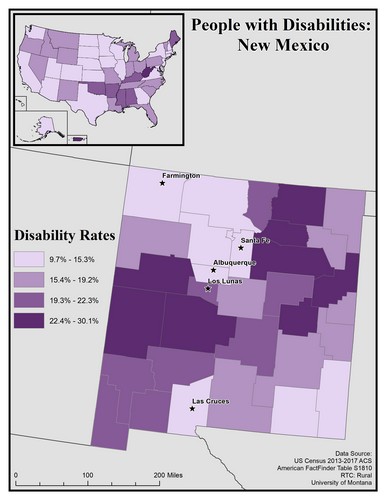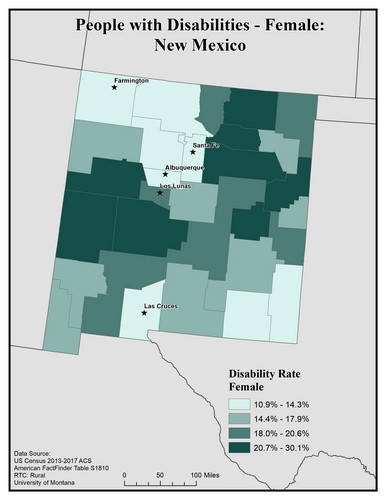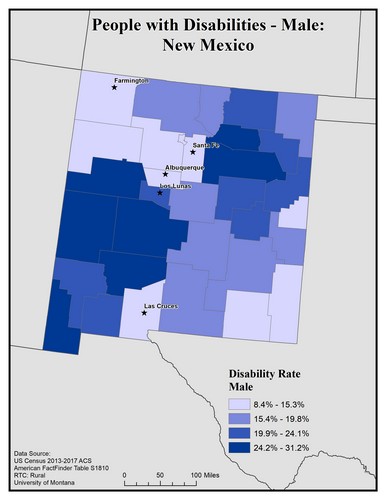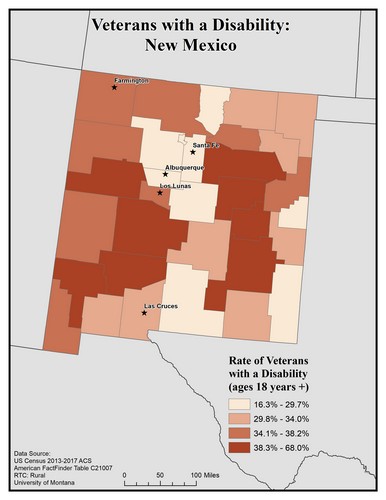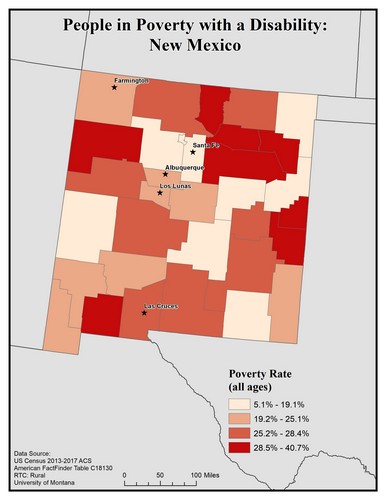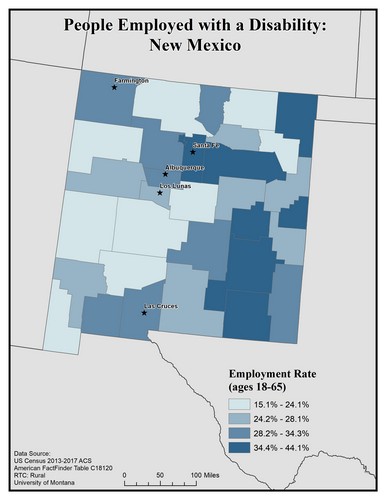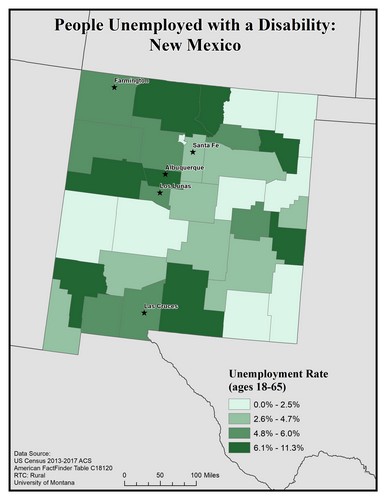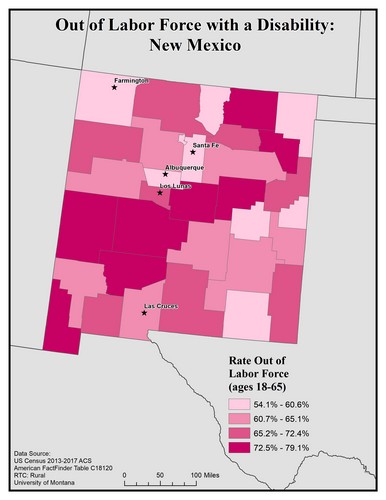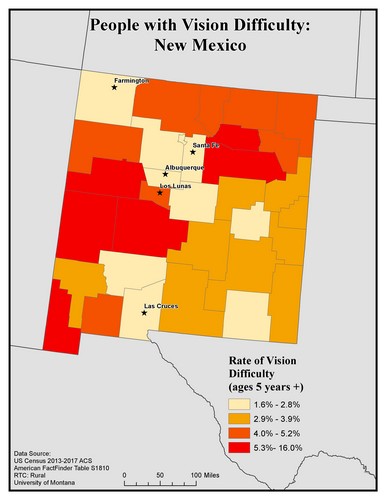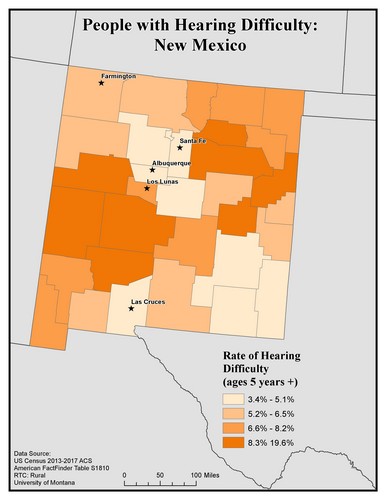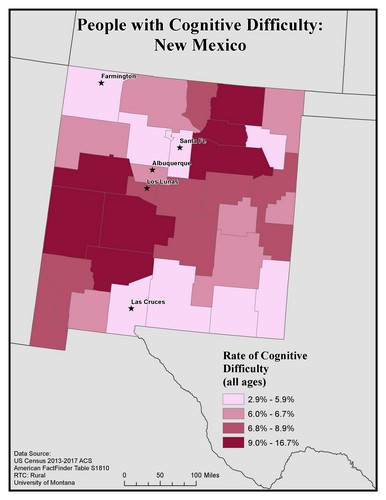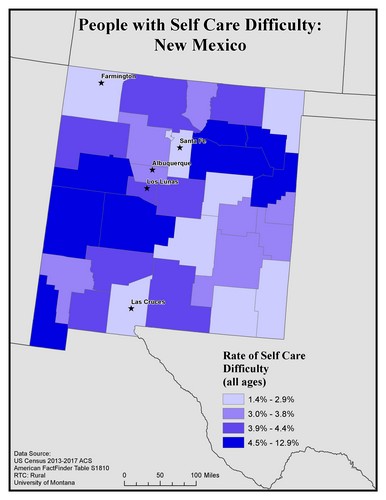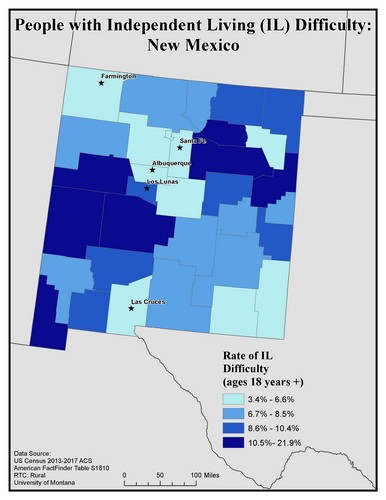New Mexico State Profile
The maps on this page explore the American Community Survey 5-year data (Table S1810) on disability by county.
The ACS does not directly measure disability. Instead, it uses a set of disability indicator questions related to difficulty and functional impairment to identify individuals who may experience a disability. If a respondent can answer “yes” to any disability question they are classified as having a disability.
Disability Rates: New Mexico
This map of New Mexico shows general rates of disability across the state at the county level. Disability rates are broken into four categories, from 9.7% to 30.1%
The five largest urban areas (Las Cruces, Los Lunas, Albuquerque, Santa Fe, and Farmington) are labeled to show if there are any differences between disability rates in urban vs rural areas. Disability rates tend to be higher in rural areas than urban ones. The lowest rates, of 9.7 to 15.3%, are mainly found in the counties surrounding each of the five largest urban areas and tend to occur in the northern and southern parts of the state. There are two large clusters of high disability rates of 22.4 to 30.1% in the rural counties in the northeastern and central-western parts of the state. There are also two clusters of the second highest category of 19.3 to 22.3% in the central and southwestern parts of the state, while an uneven pattern of disbursement can be observed of the second lowest category of 15.4 to 19.2%.
In the upper corner is an inset map of the United States showing how overall general disability rates in New Mexico compare to the rest of the country. Overall, general disability rates in New Mexico are in the second lowest category (out of four) compared to the rest of the U.S.
Map produced October 2019 based on 2013-2017 American Community Survey data.
- Click on the map for a larger, downloadable version.
- To browse or download the data used to make this map, use our Disability Data Lookup Tool.
This map of the state of New Mexico shows disability rate among females by county. Rates are broken into four categories from 10.9 to 30.1%.
The five largest urban areas (Las Cruces, Los Lunas, Albuquerque, Santa Fe, and Farmington) are labeled on the map to show if there are any differences between rates in urban compared to rural areas.
Los Lunas is in a county with the second-highest rate of 18.0 to 20.6%. The other four cities are in counties with the lowest rate of 10.9 to 14.3%.
Map produced July 2020 based on 2013-2017 American Community Survey data.
- Click on the map for a larger, downloadable version.
- To browse or download the data used to make this map, use our Disability Data Lookup Tool.
- For information on how biological sex is used and defined in the ACS, see “American Community Survey and Puerto Rico Community Survey 2017 Subject Definitions” page 125.
This map of the state of New Mexico shows disability rate among males by county. Rates are broken into four categories from 8.4% to 31.2%.
The five largest urban areas (Las Cruces, Los Lunas, Albuquerque, Santa Fe, and Farmington) are labeled on the map to show if there are any differences between rates in urban compared to rural areas.
Los Lunas is in a county with the second-highest rate of 19.9 to 24.1%. The other four cities are in counties with the lowest rate of 8.4 to 15.3%.
Map produced July 2020 based on 2013-2017 American Community Survey data.
- Click on the map for a larger, downloadable version.
- To browse or download the data used to make this map, use our Disability Data Lookup Tool.
- For information on how biological sex is used and defined in the ACS, see “American Community Survey and Puerto Rico Community Survey 2017 Subject Definitions” page 125.
This map explores the American Community Survey (ACS) 5-year data (Table S1810) on disability estimates.
The ACS asks a set of disability indicator questions to determine disability. If a respondent can answer “yes” to any disability question they are classified as having a disability. The data below are for ages 18 and over.
This map of the state of New Mexico shows rates of disability among veterans aged 18 and older by county. Rates are broken into four categories from 16.3 to 68.0%.
The five largest urban areas (Las Cruces, Los Lunas, Albuquerque, Santa Fe, and Farmington) are labeled on the map to show if there are any differences between rates in urban compared to rural areas.
Albuquerque and Santa Fe are in counties with the lowest rate of 16.3 to 29.7%. Las Cruces is in a county with the second-lowest rate of 29.8 to 34.0%. Los Lunas and Farmington are in counties with the second-highest rate of 34.1 to 38.2%.
Map produced July 2020 based on 2013-2017 American Community Survey data.
- Click on the map for a larger, downloadable version.
- To browse or download the data used to make this map, use our Disability Data Lookup Tool.
This map of the state of New Mexico shows poverty rates among people with disabilities of all ages by county. Poverty rates are broken into four levels from 5.1 to 40.7%.
The five largest urban areas (Las Cruces, Los Lunas, Albuquerque, Santa Fe, and Farmington) are labeled on the map to show if there are any differences between rates in urban compared to rural areas.
Santa Fe is in a county with the lowest rate of 5.1 to 19.1%. Albuquerque, Los Lunas and Farmington are in counties with the second-lowest rate of 19.2 to 25.1%. Las Cruces is in a county with the second-highest rate of 25.2 to 28.4%.
Map produced July 2020 based on 2013-2017 American Community Survey data.
- Click on the map for a larger, downloadable version.
- To browse or download the data used to make this map, use our Disability Data Lookup Tool.
Employment: New Mexico
This map explores American Community Survey (ACS) 5-year data (Table C18120) employment estimates by disability type.
The ACS asks a set of disability indicator questions to determine disability. If a respondent can answer “yes” to any disability question they are classified as having a disability. The data below are for ages 18-64.
This map of New Mexico shows employment rates among people with disabilities. The data includes people ages 18 to 64. Rates are broken into four categories ranging from 15.1 to 44.1%.
The five largest urban areas (Las Cruces, Los Lunas, Albuquerque, Santa Fe, and Farmington) are labeled on the map to show if there are any differences between rates in urban compared to rural areas.
Los Lunas is in a county with the second-lowest rate of 24.2 to 28.1%. Albuquerque, Farmington and Las Cruces are in counties with the second-highest rate of 28.2 to 34.3%. Santa Fe is in a county with the highest rate of 34.4 to 44.1%.
Map produced July 2020 based on 2013-2017 American Community Survey data.
- Click on the map for a larger, downloadable version.
- To browse or download the data used to make this map, use our Disability Data Lookup Tool.
This map explores American Community Survey (ACS) 5-year data (Table C18120) employment estimates by disability type.
The ACS asks a set of disability indicator questions to determine disability. If a respondent can answer “yes” to any disability question they are classified as having a disability. The data below are for ages 18-64.
This map of New Mexico shows unemployment rates among people with disabilities. The data includes people ages 18 to 64. Rates are broken into four categories from 0.0 to 11.3%.
The five largest urban areas (Las Cruces, Los Lunas, Albuquerque, Santa Fe, and Farmington) are labeled on the map to show if there are any differences between rates in urban compared to rural areas.
Santa Fe is in a county with the second-lowest rate of 2.6 to 4.7%. Los Lunas, Farmington, and Las Cruces are in counties with the second-highest rate of 4.8 to 6.0%. Albuquerque is in a county with the highest rate of 6.1 to 11.3%.
Map produced July 2020 based on 2013-2017 American Community Survey data.
- Click on the map for a larger, downloadable version.
- To browse or download the data used to make this map, use our Disability Data Lookup Tool.
This map explores American Community Survey (ACS) 5-year data (Table C18120) employment estimates by disability type.
The ACS asks a set of disability indicator questions to determine disability. If a respondent can answer “yes” to any disability question they are classified as having a disability. The data below are for ages 18-64.
This map of New Mexico shows out of labor force rates among people with disabilities. The data includes people ages 18 to 64. Rates are broken into four categories from 54.1 to 79.1%.
The five largest urban areas (Las Cruces, Los Lunas, Albuquerque, Santa Fe, and Farmington) are labeled on the map to show if there are any differences between rates in urban compared to rural areas.
Albuquerque, Santa Fe and Farmington are in counties with the lowest rate of 54.1 to 60.6%. Las Cruces is in a county with the second-lowest rate of 60.7 to 65.1%. Los Lunas is in a county with the second-highest rate of 65.2 to 72.4%.
Map produced July 2020 based on 2013-2017 American Community Survey data.
- Click on the map for a larger, downloadable version.
- To browse or download the data used to make this map, use our Disability Data Lookup Tool.
Disability Rates by Functional Limitation: New Mexico
This map explores the American Community Survey (ACS) 5-year data (Table S1810) on disability estimates by county.
For vision difficulty the ACS asks if a respondent is blind or has serious difficulty seeing, even when wearing glasses. If they answer “yes” they are classified as having a vision difficulty. This data is for all ages.
This map of the state of New Mexico shows rates of people with vision difficulty for ages 5 and older by county. Rates are broken into four categories from 1.6 to 16.0%.
The five largest urban areas (Las Cruces, Los Lunas, Albuquerque, Santa Fe, and Farmington) are labeled on the map to show if there are any differences between rates in urban compared to rural areas.
Los Lunas is in a county with the second-highest rates of 4.0 to 5.2%. The other four cities are in counties with the lowest rate of 1.6 to 2.8%.
Map produced April 2020 based on 2013-2017 American Community Survey data.
- Click on the map for a larger, downloadable version.
- To browse or download the data used to make this map, use our Disability Data Lookup Tool.
This map explores the American Community Survey (ACS) 5-year data (Table S1810) on disability estimates by county.
For hearing difficulty the ACS asks if a respondent is deaf or has serious difficulty hearing. If they answer “yes” they are classified as having a hearing difficulty. This data is for all ages.
This map of the state of New Mexico shows rates of people with hearing difficulty for ages 5 and older by county. Rates are broken into four categories from 3.4 to 19.6%.
The five largest urban areas (Las Cruces, Los Lunas, Albuquerque, Santa Fe, and Farmington) are labeled on the map to show if there are any differences between rates in urban compared to rural areas.
Santa Fe, Albuquerque, and Las Cruces are in counties with the lowest rate of 3.4 to 5.1%. Farmington is in a county with the second-lowest rate of 5.2 to 6.5%. Los Lunas is in a county with the second-highest rate of 6.6 to 8.2%.
Map produced April 2020 based on 2013-2017 American Community Survey data.
- Click on the map for a larger, downloadable version.
- To browse or download the data used to make this map, use our Disability Data Lookup Tool.
This map explores the American Community Survey (ACS) 5-year data (Table S1810) on disability estimates by county.
For cognitive difficulty the ACS asks because of a physical, mental, or emotional problem, does the respondent have difficulty remembering, concentrating, or making decisions. If they answer “yes” they are classified as having a cognitive difficulty. This data is for ages 5 and up.
This map of the state of New Mexico shows rates of people with cognitive difficulty by county. Rates are broken into four categories from 2.9 to 16.7%.
The five largest urban areas (Las Cruces, Los Lunas, Albuquerque, Santa Fe, and Farmington) are labeled on the map to show if there are any differences between rates in urban compared to rural areas.
Sante Fe, Farmington, and Las Cruces are in counties with the lowest rate of 2.9 to 5.9%. Albuquerque is in a county with the second-lowest rate of 6.0 to 6.7%. Los Lunas is in a county with the second-highest rate of 6.8 to 8.9%.
Map produced April 2020 based on 2013-2017 American Community Survey data.
- Click on the map for a larger, downloadable version.
- To browse or download the data used to make this map, use our Disability Data Lookup Tool.
This map explores the American Community Survey (ACS) 5-year data (Table S1810) on disability estimates by county.
For ambulatory (i.e. mobility) difficulty the ACS asks if a respondent has serious difficulty walking or climbing stairs. If they answer “yes” they are classified as having a mobility difficulty. This data is for ages 5 and up.
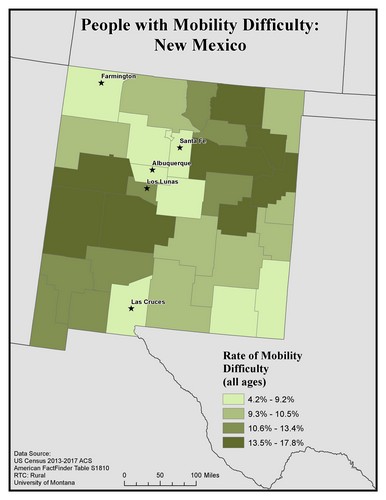 This map of the state of New Mexico shows rates of people with mobility difficulty for all ages by county. Rates are broken into four categories from 4.2 to 17.8%.
This map of the state of New Mexico shows rates of people with mobility difficulty for all ages by county. Rates are broken into four categories from 4.2 to 17.8%.
The five largest urban areas (Las Cruces, Los Lunas, Albuquerque, Santa Fe, and Farmington) are labeled on the map to show if there are any differences between rates of people with mobility difficulty in urban compared to rural areas.
Los Lunas is in a county with the second-highest rate of 10.6 to 13.4%. The other four cities are in counties with the lowest rate of 4.2 to 9.2%.
Map produced April 2020 based on 2013-2017 American Community Survey data.
- Click on the map for a larger, downloadable version.
- To browse or download the data used to make this map, use our Disability Data Lookup Tool.
This map explores the American Community Survey (ACS) 5-year data (Table S1810) on disability estimates by county.
For self-care difficulty the ACS asks if a respondent has difficulty bathing or dressing. If they answer “yes” they are classified as having a self-care difficulty. This data is for ages 5 and up.
This map of the state of New Mexico shows rates of people with self-care difficulty by county. Rates are broken into four categories from 1.4 to 12.9%.
The five largest urban areas (Las Cruces, Los Lunas, Albuquerque, Santa Fe, and Farmington) are labeled on the map to show if there are any differences between rates in urban compared to rural areas.
Sante Fe, Farmington, and Las Cruces are in counties with the lowest rate of 1.4 to 2.9%. Albuquerque is in a county with the second-lowest rate of 3.0 to 3.8%. Los Lunas is in a county with the second-highest rates of 3.9 to 4.4%.
Map produced April 2020 based on 2013-2017 American Community Survey data.
- Click on the map for a larger, downloadable version.
- To browse or download the data used to make this map, use our Disability Data Lookup Tool.
This map explores the American Community Survey (ACS) 5-year data (Table S1810) on disability estimates by county.
For independent living difficulty the ACS asks because of a physical, mental, or emotional problem, does the respondent have difficulty doing errands alone such as visiting a doctor’s office or shopping. If they answer “yes” they are classified as having an independent living difficulty. This data is for ages 18 and up.
This map of the state of New Mexico shows rates of independent living (IL) difficulty for people 18 years of age and older by county. Rates are broken into four categories from 3.4 to 6.6%.
The five largest urban areas (Las Cruces, Los Lunas, Albuquerque, Santa Fe, and Farmington) are labeled on the map to show if there are any differences between rates of people with independent living difficulty in urban compared to rural areas.
Los Lunas is in a county with the second-highest rate of 8.6 to 10.4%. The other four cities are in counties with the lowest rate of 3.4 to 6.6%.
Map produced April 2020 based on 2013-2017 American Community Survey data.
- Click on the map for a larger, downloadable version.
- To browse or download the data used to make this map, use our Disability Data Lookup Tool.

